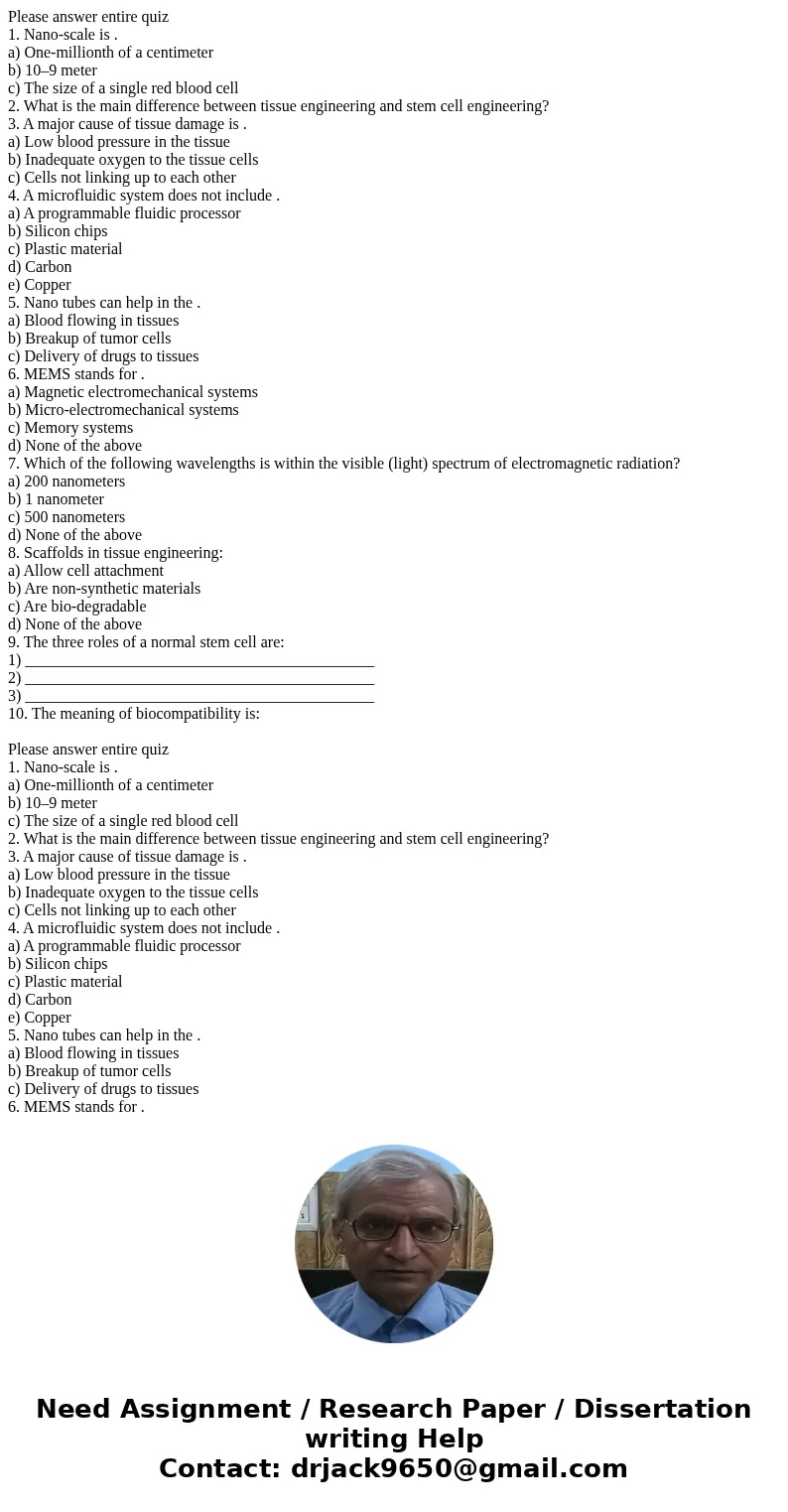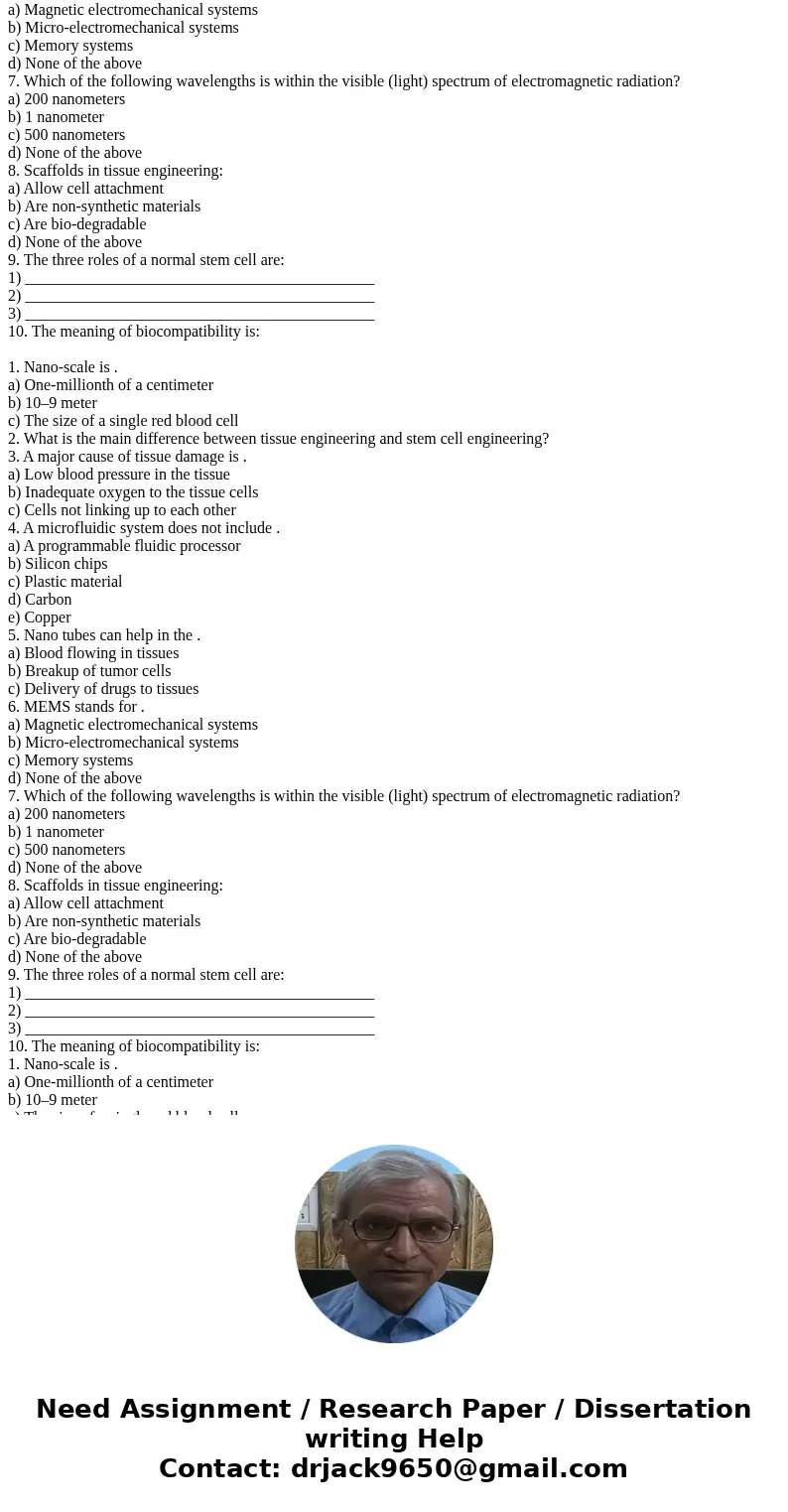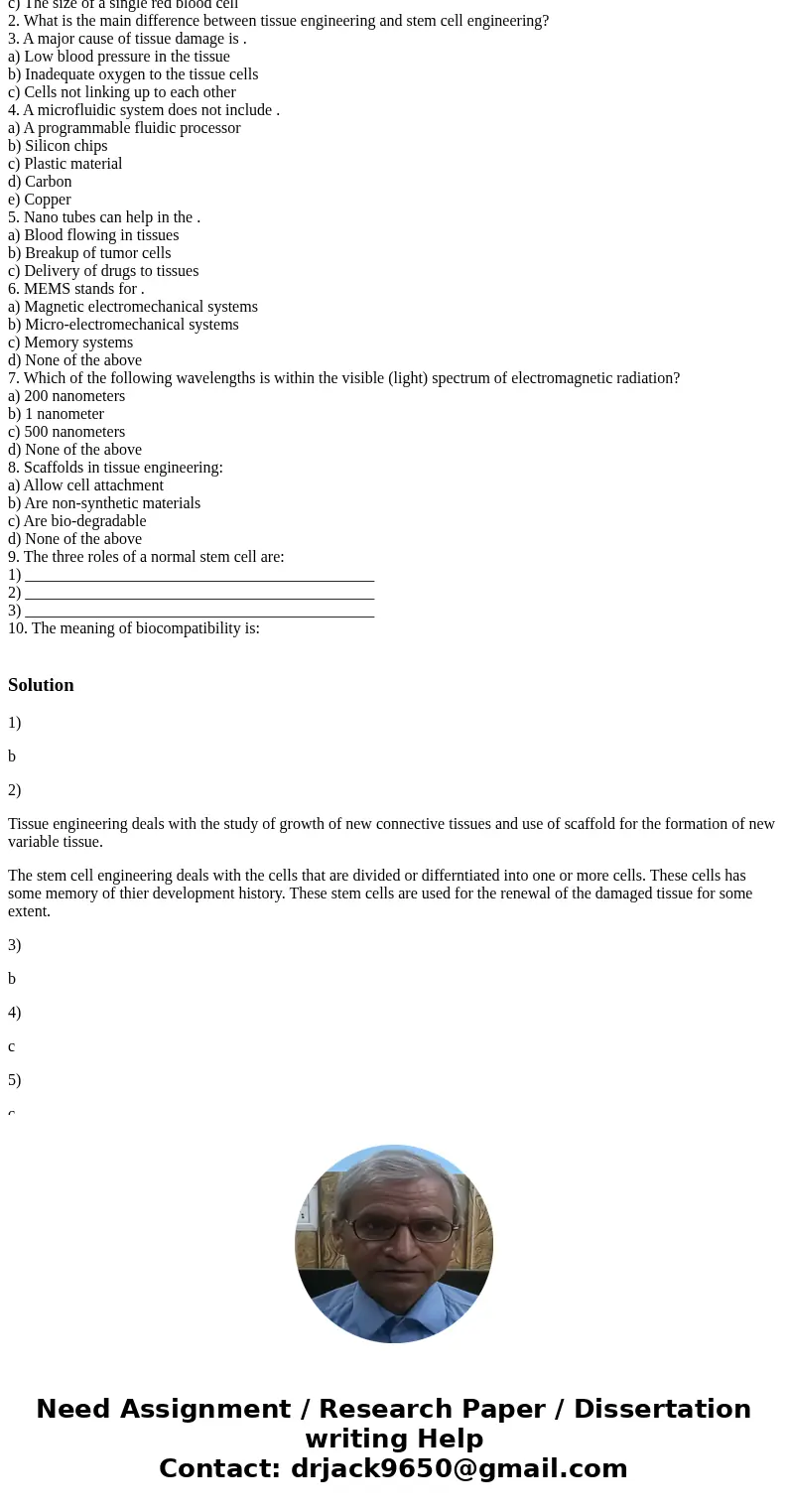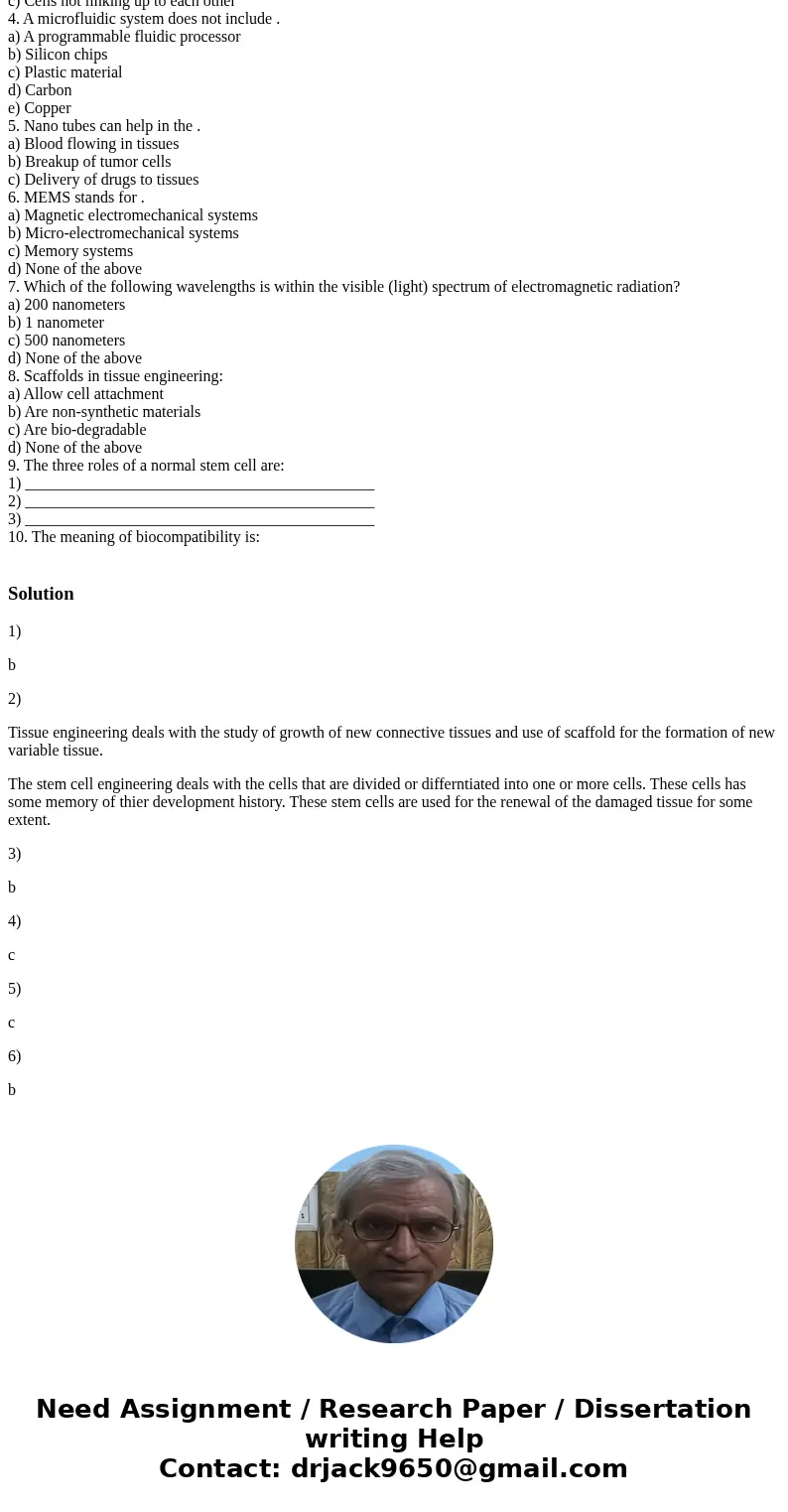Please answer entire quiz 1 Nanoscale is a Onemillionth of
Please answer entire quiz
1. Nano-scale is .
a) One-millionth of a centimeter
b) 10–9 meter
c) The size of a single red blood cell
2. What is the main difference between tissue engineering and stem cell engineering?
3. A major cause of tissue damage is .
a) Low blood pressure in the tissue
b) Inadequate oxygen to the tissue cells
c) Cells not linking up to each other
4. A microfluidic system does not include .
a) A programmable fluidic processor
b) Silicon chips
c) Plastic material
d) Carbon
e) Copper
5. Nano tubes can help in the .
a) Blood flowing in tissues
b) Breakup of tumor cells
c) Delivery of drugs to tissues
6. MEMS stands for .
a) Magnetic electromechanical systems
b) Micro-electromechanical systems
c) Memory systems
d) None of the above
7. Which of the following wavelengths is within the visible (light) spectrum of electromagnetic radiation?
a) 200 nanometers
b) 1 nanometer
c) 500 nanometers
d) None of the above
8. Scaffolds in tissue engineering:
a) Allow cell attachment
b) Are non-synthetic materials
c) Are bio-degradable
d) None of the above
9. The three roles of a normal stem cell are:
1) ____________________________________________
2) ____________________________________________
3) ____________________________________________
10. The meaning of biocompatibility is:
Please answer entire quiz
1. Nano-scale is .
a) One-millionth of a centimeter
b) 10–9 meter
c) The size of a single red blood cell
2. What is the main difference between tissue engineering and stem cell engineering?
3. A major cause of tissue damage is .
a) Low blood pressure in the tissue
b) Inadequate oxygen to the tissue cells
c) Cells not linking up to each other
4. A microfluidic system does not include .
a) A programmable fluidic processor
b) Silicon chips
c) Plastic material
d) Carbon
e) Copper
5. Nano tubes can help in the .
a) Blood flowing in tissues
b) Breakup of tumor cells
c) Delivery of drugs to tissues
6. MEMS stands for .
a) Magnetic electromechanical systems
b) Micro-electromechanical systems
c) Memory systems
d) None of the above
7. Which of the following wavelengths is within the visible (light) spectrum of electromagnetic radiation?
a) 200 nanometers
b) 1 nanometer
c) 500 nanometers
d) None of the above
8. Scaffolds in tissue engineering:
a) Allow cell attachment
b) Are non-synthetic materials
c) Are bio-degradable
d) None of the above
9. The three roles of a normal stem cell are:
1) ____________________________________________
2) ____________________________________________
3) ____________________________________________
10. The meaning of biocompatibility is:
1. Nano-scale is .
a) One-millionth of a centimeter
b) 10–9 meter
c) The size of a single red blood cell
2. What is the main difference between tissue engineering and stem cell engineering?
3. A major cause of tissue damage is .
a) Low blood pressure in the tissue
b) Inadequate oxygen to the tissue cells
c) Cells not linking up to each other
4. A microfluidic system does not include .
a) A programmable fluidic processor
b) Silicon chips
c) Plastic material
d) Carbon
e) Copper
5. Nano tubes can help in the .
a) Blood flowing in tissues
b) Breakup of tumor cells
c) Delivery of drugs to tissues
6. MEMS stands for .
a) Magnetic electromechanical systems
b) Micro-electromechanical systems
c) Memory systems
d) None of the above
7. Which of the following wavelengths is within the visible (light) spectrum of electromagnetic radiation?
a) 200 nanometers
b) 1 nanometer
c) 500 nanometers
d) None of the above
8. Scaffolds in tissue engineering:
a) Allow cell attachment
b) Are non-synthetic materials
c) Are bio-degradable
d) None of the above
9. The three roles of a normal stem cell are:
1) ____________________________________________
2) ____________________________________________
3) ____________________________________________
10. The meaning of biocompatibility is:
1. Nano-scale is .
a) One-millionth of a centimeter
b) 10–9 meter
c) The size of a single red blood cell
2. What is the main difference between tissue engineering and stem cell engineering?
3. A major cause of tissue damage is .
a) Low blood pressure in the tissue
b) Inadequate oxygen to the tissue cells
c) Cells not linking up to each other
4. A microfluidic system does not include .
a) A programmable fluidic processor
b) Silicon chips
c) Plastic material
d) Carbon
e) Copper
5. Nano tubes can help in the .
a) Blood flowing in tissues
b) Breakup of tumor cells
c) Delivery of drugs to tissues
6. MEMS stands for .
a) Magnetic electromechanical systems
b) Micro-electromechanical systems
c) Memory systems
d) None of the above
7. Which of the following wavelengths is within the visible (light) spectrum of electromagnetic radiation?
a) 200 nanometers
b) 1 nanometer
c) 500 nanometers
d) None of the above
8. Scaffolds in tissue engineering:
a) Allow cell attachment
b) Are non-synthetic materials
c) Are bio-degradable
d) None of the above
9. The three roles of a normal stem cell are:
1) ____________________________________________
2) ____________________________________________
3) ____________________________________________
10. The meaning of biocompatibility is:
Solution
1)
b
2)
Tissue engineering deals with the study of growth of new connective tissues and use of scaffold for the formation of new variable tissue.
The stem cell engineering deals with the cells that are divided or differntiated into one or more cells. These cells has some memory of thier development history. These stem cells are used for the renewal of the damaged tissue for some extent.
3)
b
4)
c
5)
c
6)
b




 Homework Sourse
Homework Sourse